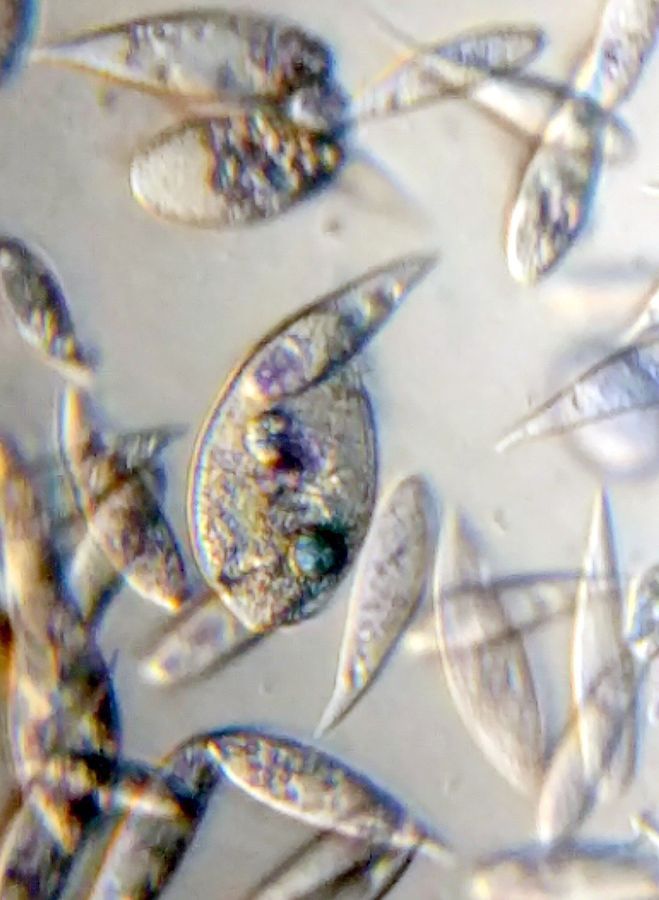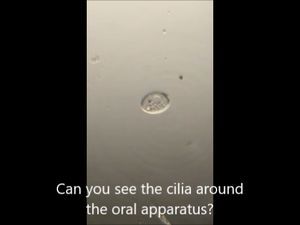Polymorphism, cannibalism, epigenetics, and biological conflict: The many stories of Tetrahymena vorax – Part I
 May 21, 2018 • 10:56 AM UTC
May 21, 2018 • 10:56 AM UTC Unknown Location
Unknown Location 140x Magnification
140x Magnification Microorganisms
Microorganisms
laksiyer
Human observer of life. https://sukshmadarshin.wordpress.com
97posts
1255comments
5locations

There are fascinating stories in biological systems and here is one I recently learnt thanks to the ASSETT program. https://tetrahymenaasset.vet.cornell.edu/science-modules/by-name/cannibalism-and-interspecific-predation/ Tetrahymena vorax is much larger than Tetrahymena thermophila . It also looks very different, swims more like a fish and very interestingly shows a great degree of polymorphisms in shape. As the resources in a growth medium depletes, or when nutrition is low, and/or if other ciliates like Tetrahymena thermophila are present in the same surroundings, Tetrahymena vorax undergoes a remarkable change, where it transforms from a small-mouthed form (microstome), to about 10 times bigger with a large mouth (macrostome). These macrostomes now either eat the microstome forms and other species in the surroundings. Experiments show that in such a situation where Tetrahymena thermophila is also present in the surroundings, they prefer it to its own microstome kin. Interestingly, under these circumstances, some of the microstome forms grow long tails and these appear to be resistant to macrostome cannibalism. What a fascinating story!! First lets look at the three forms.
1. These polymorphisms remind me of the polymorphisms in ant colonies, where soldiers can be really large compared to workers. In ants the evolution of the caste structure and specializations resulted in the selection of different sizes for different functions. What is the value of these polymorphisms in T. vorax ?
2. If one were to model these as populations, cannibalism causes a reduction or maintenance of population, as it eats its kin and then splits to give microstomes, so two replace two. So ultimately, there is really no gain in numbers. Further, as the culture grows older the proportion of the giant cannibals increase in the population. Why might it be so? It would be worthwhile quantitating the ratios of the different forms under different growth media.
3. Perhaps when resources are limiting, scavenging for other organisms, might be a better way of getting nutrition. Another thought is that if cannibalism of other species might actually be a way to get DNA from other organisms?
3. We are often used to seeing different ciliates in a pond water sample. i am now beginning to wonder how many might be the same species after all??
4. These morphological and behavioral changes with the same genetic setup suggests that macrostomy is an epigenetic phenomenon. Our group discovered candidate DNA adenine methylases in ciliates ( https://www.ncbi.nlm.nih.gov/pubmed/26660621 )– Could adenine methylation be involved in regulating macrostomy? Clearly studying epigenetic changes in the different forms is a fantastic molecular biology problem.
5. Sadly, the era of ciliate model systems is dying and sometimes I wonder if these issues will ever be looked at again with the fancier molecular biology tools of today. Most work on macrostomy described above is about 50 years old. I guess one shouldnt be too pessimistic.
Tetrahymena vorax makes fascinating stories in exhibitions. Here we are explaining the different forms at the US Science and Engineering Festival-2018, where I had the pleasure of meeting Christine and Rebecca from Foldscope Instruments.
2. If one were to model these as populations, cannibalism causes a reduction or maintenance of population, as it eats its kin and then splits to give microstomes, so two replace two. So ultimately, there is really no gain in numbers. Further, as the culture grows older the proportion of the giant cannibals increase in the population. Why might it be so? It would be worthwhile quantitating the ratios of the different forms under different growth media.
3. Perhaps when resources are limiting, scavenging for other organisms, might be a better way of getting nutrition. Another thought is that if cannibalism of other species might actually be a way to get DNA from other organisms?
3. We are often used to seeing different ciliates in a pond water sample. i am now beginning to wonder how many might be the same species after all??
4. These morphological and behavioral changes with the same genetic setup suggests that macrostomy is an epigenetic phenomenon. Our group discovered candidate DNA adenine methylases in ciliates ( https://www.ncbi.nlm.nih.gov/pubmed/26660621 )– Could adenine methylation be involved in regulating macrostomy? Clearly studying epigenetic changes in the different forms is a fantastic molecular biology problem.
5. Sadly, the era of ciliate model systems is dying and sometimes I wonder if these issues will ever be looked at again with the fancier molecular biology tools of today. Most work on macrostomy described above is about 50 years old. I guess one shouldnt be too pessimistic.
Tetrahymena vorax makes fascinating stories in exhibitions. Here we are explaining the different forms at the US Science and Engineering Festival-2018, where I had the pleasure of meeting Christine and Rebecca from Foldscope Instruments.
The best part of the foldscope is that I get to share my observations with an 8 year old and it is a lot of fun.
In my next post I shall put up my experiments with vital stains that enhance various aspects of the ciliates.
This post is open to read and review on The Winnower.
This post is open to read and review on The Winnower.
Sign in to commentNobody has commented yet... Share your thoughts with the author and start the discussion!

 0 Applause
0 Applause 0 Comments
0 Comments_300x300.jpeg)

















